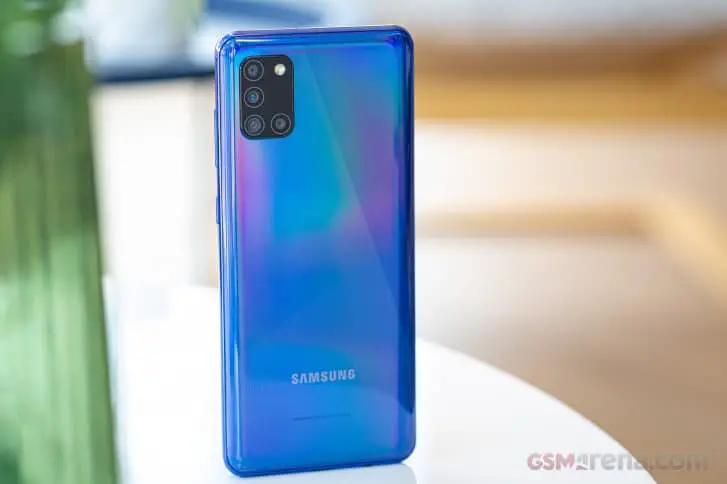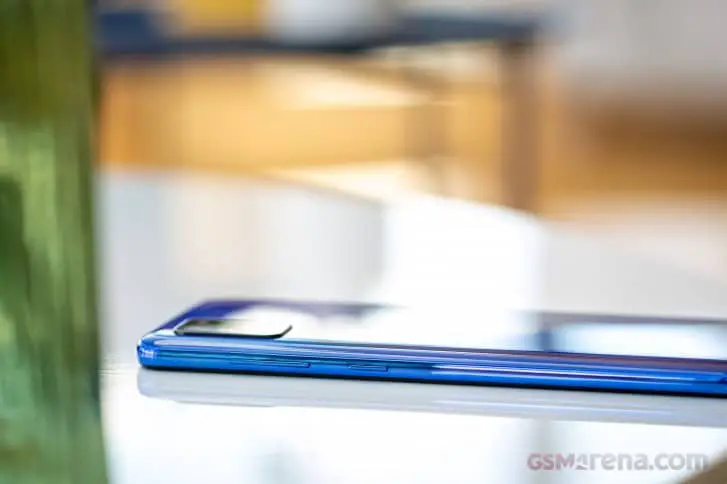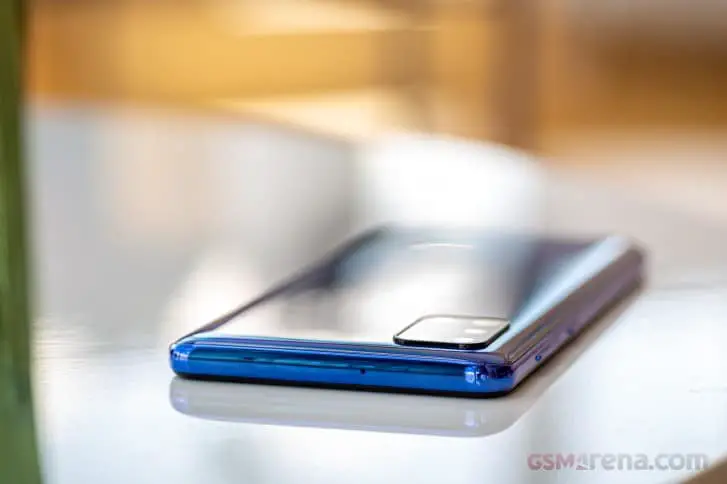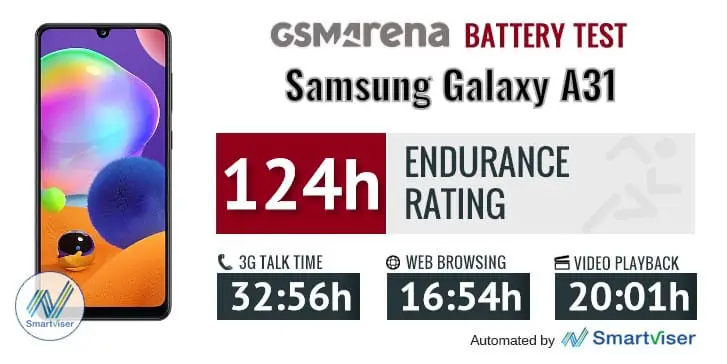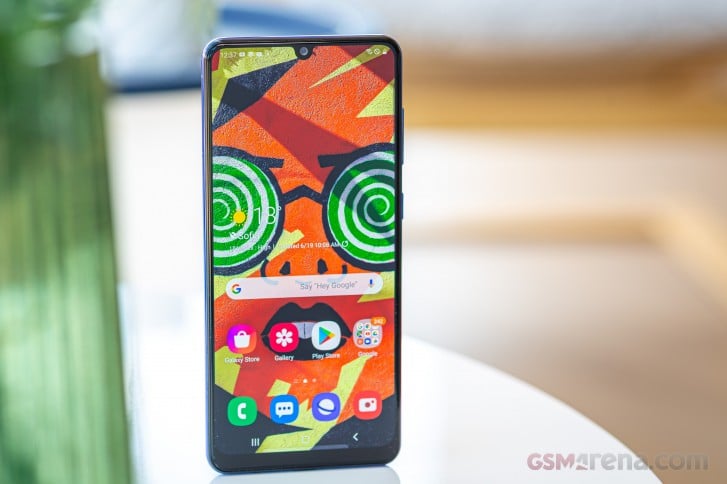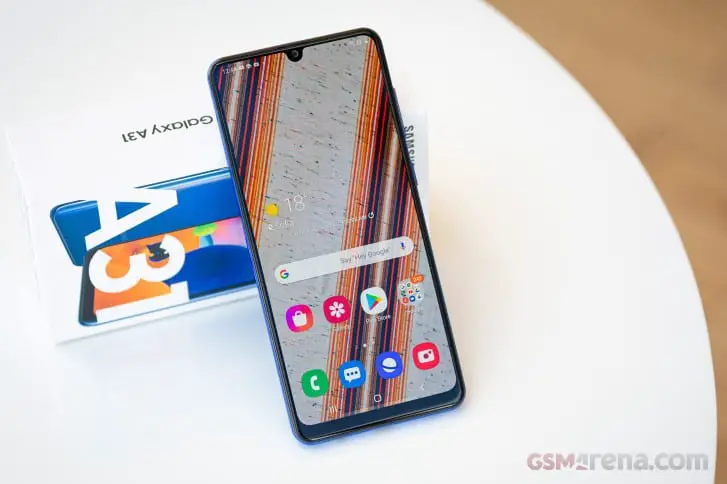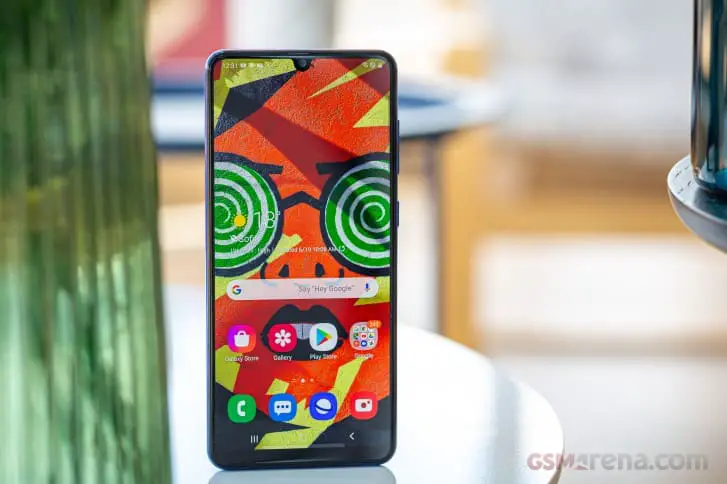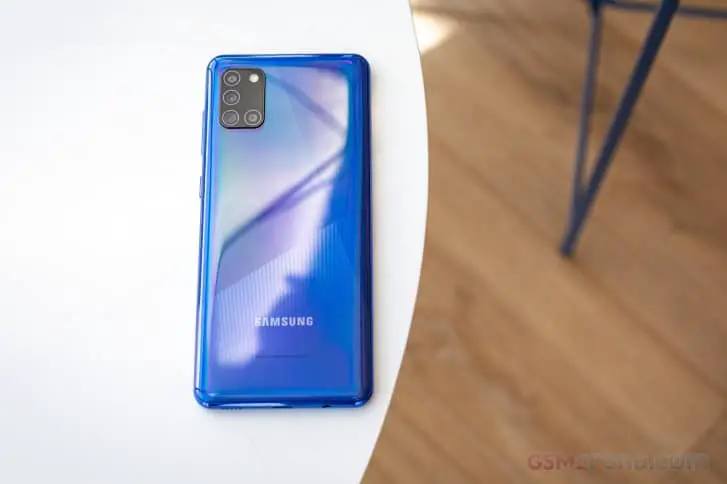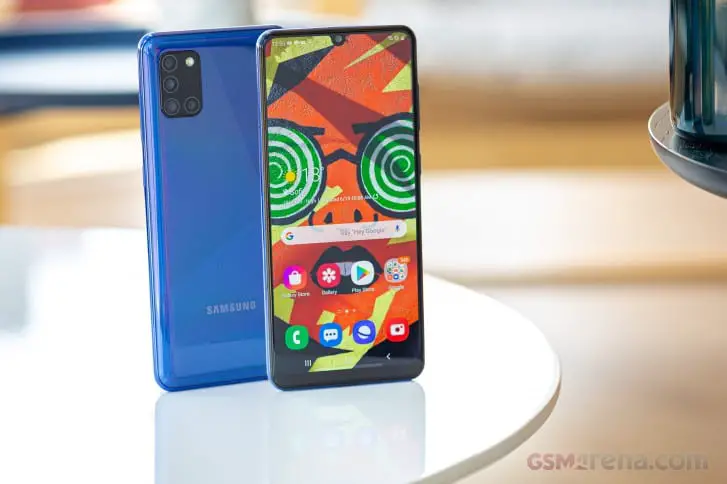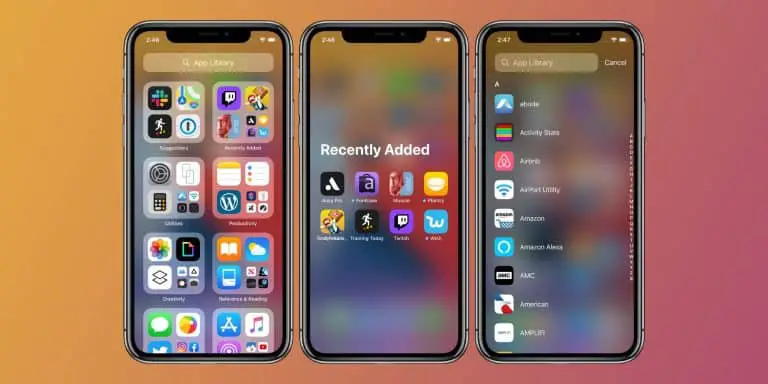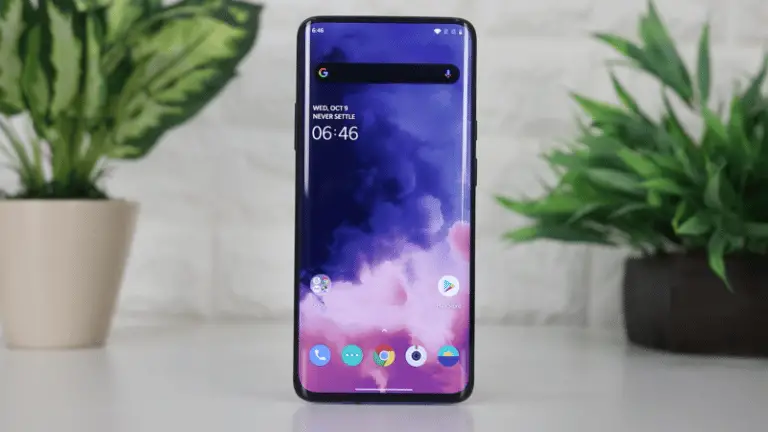Samsung Galaxy A31 review
Introduction
Navigating the -so wide- range of Samsung devices in 2020 is no easy task. The Korean giant is hardly the cause of the problem, but is still surfing on this trend of flooding the market by offering many smartphones for all expectations and all budgets. Thanks to a combination of different factors, we currently have a powerful smartphone market, where the volume and turnover of models are now at an all-time high. This is especially true for mid-range smartphones, which is precisely where the Galaxy A31 is positioned.
It's one of Samsung's cheapest entry points into Super AMOLED display technology, giving it an edge over siblings like the Galaxy A11 and A21. However, the confusion starts to set in once you look further into the Galaxy A line of devices. long and a larger 41 mAh battery. A strange choice, for sure, especially since the A31 is a little more expensive in stores than the A6,4.
Technical specifications of the Samsung Galaxy A31
- Dimensions: 159,3 × 73,1 × 8,6mm, 185g; Plastic body and frame; Colors: Prism Crush Black, Prism Crush Blue, Prism Crush Red, Prism Crush White.
- Screen: 6,40 ″ Super AMOLED, 1080x2400px resolution, 20: 9 aspect ratio, 411ppi.
- Processors: Mediatek MT6768 Helio P65 (12nm): Octa-core (Cortex-A75 2 × 2,0 GHz and Cortex-A55 6 × 1,7 GHz); Mali-G52 MC2.
- Memory : 64 GB 4 GB RAM, 128 GB 4 GB RAM, 128 GB 6 GB RAM; eMMC 5.1; microSDXC (dedicated slot).
- OS / Software: Android 10, a 2.0 user interface.
- Rear camera: Large (main): 48 MP, f / 2.0, 26mm, 1 / 2,0 ", 0,8 µm, PDAF; Ultra wide angle: 8 MP, f / 2,2, 123 °, 1 / 4,0 ", 1,12 µm; Macro: 5 MP, f / 2,4, (macro); Depth: 5 MP, f / 2,4; LED flash, panorama, HDR.
- Front camera : 20 MP, f / 2.2.
- Video capture: Rear camera: 1080p@30fps; Front camera: 1080p@30fps.
- Battery: 5000mAh; Fast charge 15W.
- Various: Fingerprint (under display, optical), accelerometer, gyroscope, proximity, compass; FM radio, RDS, recording.
Things get even stranger when the Galaxy M family kicks in. The Galaxy M21 offers the same 6,4-inch Super AMOLED display, paired with a larger 6000mAh battery and a slightly different chipset. The internal Exynos 9611 may lack raw performance from the A65's MediaTek P31, but it's built on a more efficient 10nm manufacturing node and impressively manages to compress 4K video recording and gyro EIS from of an almost identical main camera configuration. To get the same kind of video capture versatility from a Galaxy A series device, you have to look at the more expensive Galaxy A51, which relies on the Exynos 9611 chipset just like the Galaxy M21 and has a smaller 4000mAh battery.
Confusion seems to be the most appropriate response to all of this. To be fair, not all Galaxy A and Galaxy M models are universally available in all markets, although there is often a large overlap. It helps when you're trying to navigate the sea of choices.
On another positive note - the Galaxy A31, which we are reviewing today, still manages to stand out among its Galaxy A siblings as a great value offering. The one that combines the inky blacks of a Super AMOLED panel with a 5000mAh battery - the largest in the range. The Galaxy A51 beat it with 4K video capture, EIS, and the higher-res 12MP ultra-wide camera, but if none of them are particularly high on your wishlist, the Galaxy A31 is still the choice. the smartest of the lot.
Unpacking
Being part of the relatively more premium Galaxy A family still has its perks, here and there, as a richer set of accessories. Our base 64GB setup, plus 4GB Galaxy A31 review, comes with a solid, even basic pair of GH59-15055A headphones, with an in-line microphone and volume controls. In addition, a standard 15W Adaptive Fast Charging Wall Adapter and USB Type A to Type C cable. Finally, we find a soft, but thick and sturdy transparent plastic case. So, ready to go, you have everything you need to get ready.
The box itself is nothing special. The cost savings are obvious, with a sleeve in place of a top cover piece and no plastic cradles or dividers inside. Still, the outer material is ticky and perfectly sufficient to serve its purpose and protect the Galaxy A31 in transit.
Design
The general design of the Galaxy A31 has been refreshed for 2020 in a pretty similar way to the Galaxy A51, which we recently reviewed. In fact, the pair are actually quite similar in terms of their overall footprint and figure. Measuring 159,3 x 73,1 x 8,6mm, the A31 is just a bit thicker than its sibling A51. It also weighs just over 10 grams more, at 185 grams, which is easily justified by the 1000mAh of extra juice it has to carry. The same goes for the thickness. The Galaxy M21 actually comes close to the overall dimensions of the A31, while sharing a few more similarities in design, especially up front.
The Galaxy A51 and, to a lesser extent, the A41, both managed to significantly reduce all bezels around the screen and especially the chin. In that regard, the A31 still has a rather latest-gen look, with more “buffer” space on all sides of its 6,4-inch Super AMOLED. Barely a dealbreaker in the grand scheme of things, but it's still odd that even the U21 and U31 seem to have slightly thinner bezels and chins in comparison.
The design of the Infinity-U notch for the 20MP selfie still looks perfectly modern, although it is not as stylish as the Infinity-O punch hole on the Galaxy A51. We were kind of hoping that this would provide enough space for Samsung to insert a notification LED. While there's room for it, the A31 lacks one, in favor of AOD icons, pop-ups, and animations.
Considering we're already immersed in front-end comparisons of the Samsung lineup, it's worth noting that the Korean giant hasn't officially specified exactly what kind of protective surface it uses. Most sources seem to agree on Gorilla Glass, with an unknown note. In contrast, the Galaxy A51 clearly lists Gorilla Glass 3 in its specs, as do the Galaxy M21 and M31. For clarity, none of these devices offer official protection against dust or water ingress. But that's hardly expected in their price range.
The Galaxy A31 has a traditional three-layer "sandwich" construction, with all three plastic parts. It doesn't feel as premium as metal to the touch, but at least, plastic or not, the midframe feels really sturdy, with no flex. Samsung could have done a slightly better job with its finish, but that's just nit-picking.
The design team has put a lot of thought and effort into the rear of the Galaxy A31. With a trio of seemingly random lines, dividing the surface into four quadrants of a different shade and a line pattern at the bottom, the A31 looks unique. Even alongside devices like the A41 and A51, which also share this design language, you still get very distinct looks, since Samsung has decided to change the position of the lines for each. Our Prism Crush Blue unit really shines, pun intended, once it catches the light and its underside begins to glow in a full rainbow spectrum.
It should be emphasized again that the curved back side of the Galaxy A31 is made of plastic, as opposed to a more sophisticated sheet of Gorilla Glass material. The latter would have inspired a little more confidence in the overall rigidity of the phone, but also an increase in costs. Additionally, we're not sure Samsung could have stood out as unique from a design on a more specialized surface.
Pressing down on the back with a single viewfinder reveals a bit of flex. There might have been room inside for a slightly larger battery, but one just wasn't in the budget. Even so, the A31 feels sturdy and well put together. The plastic surface provides good grip. The slightly angled curvature of the back also facilitates handling. Fingerprints are still plentiful.
Besides the unique geometric pattern on the back, you can distinctly identify the A31 as a Samsung 2020 phone thanks to its main camera cluster design. Like it or not, oversized rectangular clusters in the upper left corner that group all shooters under one roof are how the company's phones have now adapted to the ever-growing number of mods. On the Galaxy A31, in particular, the whole thing is just slightly raised above the rest of the back and doesn't introduce wobble.
Buttons and controls
The Galaxy A31 takes a conventional approach to its control scheme. On the right - a power button and volume rockers. Ideally positioned in height, "clicky" and responsive. Maybe, just a little thinner, but not in an unusual way, even with big fingers.
You probably won't hit the power button too often if you go with one of the biometric security options. On the A31, these include facial recognition and an integrated fingerprint reader.
Unfortunately, the particular fingerprint module on the A31 didn't impress us with the speed. Unlocking the phone from an off screen, using the always-on feature of the fingerprint reader takes a good two to three seconds. Yet at least the reading accuracy is high.
On a side note, Samsung now has separate information menus for checking and obtaining security fixes specifically for its biometric security, instead of only delivering them with an overall OTA OS update. Cared for.
The left side of the bezel only houses a nanoSIM, plus a microSD combo tray. Its shape is a bit odd since Samsung has gone for an extra-large approach. On one side - two separate nanoSIM slots (or one, if you get a single SIM unit like we did), on the other side - a dedicated space for a microSD card. This way you don't have to choose between a second SIM card or more storage which is a plus in our book.
The lower side of the A31 is rather busy. A USB Type-C port takes center stage. It also supports USB 2.0 and USB OTG speeds. Next to it is an old 3,5mm audio jack on one side and a single bottom speaker on the other. Unfortunately, the A31 does not have a stereo speaker setup.
Since we've kind of touched on connectivity here, it's worth noting that the A31 has an FM radio receiver with RDS. In addition, NFC, complete with two distinct modes of operation - a full mode, with read and write and a "card mode", which leaves only the authentication capabilities enabled, for use with payments, transport cards. and others.
6,4-inch Super AMOLED display
The Galaxy A31 is one of the cheapest options with an OLED panel in Samsung's current lineup. Most of the budget options beyond that rely on PLS TFT. That alone is a reason to consider opting for an A31. Super AMOLED may be a legacy tech in Samsung's list at this point, but it still delivers solid performance.
We measured a respectable 420 nits of peak brightness in our tests. The Galaxy A31 has a maximum auto mode on top of that, allowing it to temporarily boost its brightness up to 635 nits. This makes it usable outdoors, under direct sunlight without any problem.
And thanks to OLED technology, the screen contrast ratio is amazing with beautiful and deep blacks.
| Display test | 100% brightness | ||
| Ink, |
white, |
Contrast ratio | |
| Xiaomi Redmi K30 (Max Auto) | 0.527 | 714 | 1355:1 |
| Samsung Galaxy M30s (Max Auto) | 0 | 642 | ∞ |
| Samsung Galaxy A51 (Max Auto) | 0 | 636 | ∞ |
| Samsung Galaxy A31 (Max Auto) | 0 | 635 | ∞ |
| Samsung Galaxy A41 (Max Auto) | 0 | 624 | ∞ |
| Xiaomi Redmi Note 9 Pro (Max Auto) | 0.487 | 616 | 1265:1 |
| Nokia 7.2 (Max Auto) | 0.421 | 585 | 1390:1 |
| Xiaomi Redmi Note 9S (Max Auto) | 0.42 | 575 | 1369:1 |
| Xiaomi Redmi K30 | 0.399 | 550 | 1378:1 |
| Nokia 7.2 | 0.371 | 498 | 1342:1 |
| Huawei P40 Lite | 0.425 | 461 | 1085:1 |
| Redmire Xiaomi Note Pro 9 | 0.355 | 456 | 1285:1 |
| Realm 6 | 0.343 | 451 | 1315:1 |
| Realme x | 0 | 448 | ∞ |
| Samsung Galaxy M30s | 0 | 441 | ∞ |
| Samsung Galaxy A31 | 0 | 423 | ∞ |
| Xiaomi Redmi Note 9S | 0.303 | 421 | 1389:1 |
| Samsung Galaxy A41 | 0 | 417 | ∞ |
| Samsung Galaxy A51 | 0 | 413 | ∞ |
Full HD, or rather 1080 x 2400 pixels, in this case, is crisp on the 6,4-inch diagonal with a pixel density of around 411 ppi. Samsung's panels grow steadily in the vertical direction. The 20: 9 aspect ratio is more or less the current standard and the Galaxy A31 shares this trend.
Samsung has a proven track record by offering screens that are not only bright, but also performant with color reproduction. This is true for the Galaxy A31. In its default Vivid mode, it managed to achieve an average deltaE2000 of 5,1, with a considerable max deviation of 14,4 in red. Colors have that distinct “punchy” OLED look in this mode. The exaggerated red channel results in an overall "warmer" color profile, for lack of a better term. If you find that a bit off-putting, the brightness settings section includes both a simple cool and warm slider, as well as a custom white point setting, which we appreciate.
The natural mode is what you should go for if you want precise colors. We measured an impressive average deltaE 2000 of just 1,8 in this mode and a maximum of 4,7 in green, with the other colors keeping significantly smaller variance. Naturally our first instinct was to try and recall the badly behaving green channel in the custom white point menu. However, it is only available in vivid mode. After a lot of hacking, we haven't been able to get a better calibration than the one Samsung already offers in Natural mode. However, the results we measured in Natural mode are already sufficient for the panel to be considered as true to color.
There is no sophisticated HDR support on the Galaxy A31. Not that we expected in its price segment. However, the phone has Widevine L1 certification which means it can enjoy HD and higher streaming resolutions thanks to services like Netflix and Amazon Prime Video.
Autonomy
The Galaxy A31 packs a powerful 5000mAh battery. Bigger than the 4000 mAh of the Galaxy A51 and even bigger than the 3500 mAh of the Galaxy A41. The Galaxy M21 and M31 offer up to 6000mAh, which could be important for the context.
The Galaxy A31 managed an impressive 124 hours of endurance in our exclusive test, with solid scores across all levels, in every sub-category. There is nothing to complain about in this department.
Our battery tests were automated thanks to SmartViser, using its viSer application. The endurance rating above shows how long a single battery charge will last if you use the Samsung Galaxy A31 for one hour for telephony, web browsing, and video playback per day. We've established this usage pattern so that our battery results are comparable across devices in the most common day-to-day tasks. The battery test procedure is described in detail in case you are interested in the details. You can check out our full battery test table, where you can see how all of the smartphones we've tested will compare in your own regular use.
The load on the Galaxy A31 and the current Galaxy A and Galaxy M families, in general, is capped at 15W. There is nothing to call home in the modern smartphone scene. Still, there is an argument to be made to mitigate battery degradation over time by opting for a more moderate charge speed.
By charging from scratch, we were able to recover around 30% of the battery charge in 30 minutes, with a full charge taking almost 3 hours (2h48). Perfectly usable on a budget device but far from being at the top of the charts.
Speaker
The Galaxy A31 only has one speaker at its disposal. It's a bottom-firing unit, which makes it less than ideal for media consumption.
The speaker is not particularly loud and is mainly tuned to amplify the louder mid tones. Still, it does surprisingly well with vocals and even manages to retain some of the lower bass frequencies. While we wouldn't go praise him for his music that has been listened to by any stretch of the imagination, he seems to be doing pretty well among his budget peers. It is perfectly usable for following dialogue in movies and TV shows.
One UI 2.1 interface, better than Android 10
The Galaxy A31 comes with Samsung's current and up-to-date software combo consisting of Android 10 with OneUI 2.1 on top. The Korean giant has managed to maintain a surprisingly consistent look for their custom skin for quite some time now. The most recent upgrades are subtle and primarily aimed at refining the experience further. Things like sizing important interactive components and optimizing element placement for easier accessibility. All the while, existing Samsung users on older devices should feel right at home with the general layout.
OneUI 2.1 has reached a level of maturity where simplicity, order and good organization are acquired. The Galaxy A31 greets you with a lock screen and simple home screens, with a full set of customization features as well as various widgets for the Always-On display.
If you like customization, OneUI is surprisingly malleable. The capabilities of the built-in themes are extensive and include a rich online repository of free and paid options. You can mix and match individual aspects of the design, such as icons. You can also automatically change the background of the lock screen.
The Always On display feature can also be highly customized. Beyond a built-in selection of watch faces, you also get interactive controls, Samsung calls it FaceWidgets. Also, there is an entire section in the Samsung Theme store dedicated to AOD animations.
Samsung also gets top marks for incorporating what were originally flagship software features into the rest of its lineup. The on-board display is a notable example. Dash panels are a well-known and long-standing feature that gives you quick access to apps, actions, tools, and more. in a single lateral slide. You can choose which side the handle is on and adjust its position along the edge of the phone.
There's also Edge lighting - it's a feature that can light up different types of edge glow for notifications, and as you've probably guessed, there are tons of options and styles to choose from.
Samsung is all-inclusive when it comes to navigation options. Out of the box, the Galaxy A31 is configured with the familiar old-school navigation bar. Gesture navigation is also available, and you can choose between the One UI 2 action set or go back to how to do One UI 1. The former is similar to the current native Android 10 approach with a side swipe for "Back" and a swipe up to the home or task selector. The old way is to drag three separate areas at the bottom that do what the onscreen buttons before them did. It works well with Samsung Pay's default interface, if that's your cup of tea.
Dark Mode is a relatively new feature, at least in its current state, dynamic and customizable. It dresses the UI elements in black and shades of dark gray and also invokes the dark modes of supported apps, which includes internal apps as well as most of the Google suite. Oh, and the GSMArena app, since its last update. You can also use an automatic scheduling system that switches to dark mode at sunrise and sunset respectively or set your own schedule based on the weather.
Galaxy A31 biometrics include optical fingerprint reader and basic face detection only by camera. We have little problem with the fingerprinting process other than being a bit slow. It's easy to forgive, however, since you only have to do it once.
After that, the Galaxy A31 achieved a high level of consistency in fingerprint recognition, which is a potential benefit of using a traditional optical reader, instead of the company's more complicated and often inconsistent ultrasound units. .
However, speed is still an issue in everyday use. It's not the fastest of sensors and looks slow like the ultrasonic units used in Samsung flagships, as opposed to a good near-instant optical sensor used by Chinese brands. Slow unlock animation does not help with perceived speed. Our point is that this fingerprint reader is mostly usable and doesn't get in the way much, but we've seen a lot faster.
On a more positive note, we appreciate the inclusion of separate menus and fetching updates for biometric fingerprint and facial recognition security patches. It is also worth noting the possibility of speeding up facial recognition at the expense of some security. The phone even lets you bypass the requirement to open your eyes for the unlock to work.
As a result of some of its extensive partnerships with third parties, like Microsoft, Samsung is also launching a few preloaded MS apps out of the box, to go along with its already above-average collection of in-house offerings. This might be considered a bloat by Android purists, but if you don't want to use them Microsoft apps aren't too much in your face.
There are also features like seamless connectivity with Windows 10, Samsung's excellent Health suite, and SmartThings home and IoT automation hub, Game Launcher and Game Booster, AR Zone, with Doodle and AR Emoji support and they are all integrated seamlessly into OneUI 2.1.
Benchmarks / performance
Armed with a MediaTek MT6768 Helio P65 chipset, the Galaxy A31 is hardly a powerhouse. Two Cortex-A75 cores, with a maximum frequency of 2,0 GHz and six Cortex-A55, running with a 1,7 GHz cap doesn't scream performance, even on paper. Even so, this is the first time that a Helio P65 has visited the office for proper testing. This alone deserves special attention. Doubly so, because we really wanted to see how it compares to Samsung's in-house Exynos 9611 - a popular alternative in this price segment, especially for powering devices like the Galaxy M21, M31, M30, and A51.
The Exynos 9611 uses a slightly more efficient 10nm process than the 12nm node of the Helio P65. Its DSP is also capable of capturing 4K videos, which the MediaTek and therefore the Galaxy A31 are sorely lacking. Maybe the Helio P65 can then compensate for the difference in raw power through the use of its new cores? Well, starting with GeekBench and some pure CPU loads, we find a very small difference between the two and not always in MediaTek's favor.
The Helio P65 manages to outperform the Exynos 9611 in single-core loads, albeit barely, but then fails under multi-core load. The difference in processor performance is barely large enough between the two to be noticeable in the real world. Still, with better features on its side, the Exynos 9611 seems to steal the show from the P65, putting it and the Galaxy A31 in a tough spot.
Beyond this one on a battle, we can clearly see that MediaTek's G80 and G90 chip family, as well as Snapdragon's 700 line and Huawei's mid-range Kirin 810 are all a noticeable step forward. top in terms of performance. All the while, they can be found in a handset in the same approximate price range as the Galaxy A31.
Moving on to more compound performance numbers and AnTuTu 8, unfortunately we find the Galaxy A31 at the bottom of the pack. This can be attributed, at least in part, to the fact that our review unit is the base configuration, with 4GB of RAM and 64GB of storage. AnTuTu takes into account the memory and especially its speed. Perhaps the larger optional 6GB RAM chips on the A31 would have scored better. The same is true for 128GB storage chips, as SSD drives generally perform better as their capacity increases. Even so, it should be noted that the Galaxy A31 uses eMMC 5.1 for its storage, as opposed to UFS 2.0, as found in something like the Galaxy A51. The latter standard is generally faster.
Unfortunately, bad news continues for the Galaxy A31 in graphics tests as well. Starting with the lowest intensity test we are doing yet, using OpenGL ES 3.0, we see the Mali-G52 MC2 struggling to even cross the 30 fps mark both on-screen and off-screen. .
Looking at the Galaxy A51 and its Mali-G3 MP72 chipset in the same tests, we notice a few fewer frames in overall performance. However, in a strange development, the Galaxy M30, M21 and M31, all equipped with the same Exynos 9611 chipset and the same Mali-G3 MP72 GPU as the Galaxy A51, manage to score significantly higher and easily outperform the A51 and A31. We ran our tests again and crossed this strange finding with the GFX 3.1 runs as well, just to find the same relative results.
For some odd reason, the Exynos 9611 appears to perform far less inside the Galaxy A51 than it does in a trio of Galaxy M-series devices, all with consistent results. And, mind you, we're only comparing offscreen rendering results here, where native display resolution isn't a factor.
Things got even stranger in the higher-level Aztek GFXBench tests. Here, the Galaxy A51 managed to close the gap and aligned with its brother Galaxy M. All the while, leaving the Galaxy A31 at the bottom of another chart. We ran the test several times and the numbers always came back consistent. Through Vulkan and OpenGL 3.1, nothing less.
The only logical explanation we can find is a problem with the current state of the Helio P65 GPU drivers. Either that or the Galaxy A31, in particular, hits another hardware bottleneck hard during all of that GPU testing, bringing its scores down. We are hesitant to blame the Mali-G52 MC2 GPU directly, as it is also found in the Xiaomi Redmi Note 9 and Realme 6i and performs significantly better under their respective Helio G85 and Helio G80 chipsets.
For more proof, here are the 3DMark numbers, showing exactly the same trend.
After analyzing all the data, we lean heavily towards our theory of driver or software optimization issues, which hurts synthetic runs on the MediaTek Helio P65 in its current state. However, even though we assume the Galaxy A31 is expected to be nearly identical in CPU and GPU performance to its Samsung siblings, running the Exynos 9611, that still leaves it at a noticeable disadvantage. Namely, Samsung's own chip has the advantage of a more efficient manufacturing node and a more capable camera DSP, pushing 4K video capture.
Beyond that, it's hard to ignore the difference in performance between the Samsung group of handsets in these graphics and some similarly priced competitors, mostly due to their objectively better chips. If you're looking for the best performance per dollar, then silicon like the Helio G90T or Snapdragon 730G are clearly better choices.
The Galaxy A31 performs flawlessly, with no slowdowns or stuttering during everyday use. The underperforming GPU, however, makes it difficult to recommend playing graphics-intensive games.
Camera
Samsung's camera choices for the Galaxy A31 are expected and unsurprising in many ways. While devices like the Galaxy A51 and Galaxy M31 put a few twists on a generally familiar mid-tier setup, the A31 simply follows current convention.
The Quad Bayer 48MP main camera is what you would likely see on most modern midrangers. It is reliable and has proven itself time and time again.
Accompanying him on the A31 is an ultra-wide 8MP snapper. This is a notable downgrade from the 12MP unit on the A51.
Complementing these two we have a 5MP camera duo - one is a dedicated depth sensor, with an above-average megapixel count and an equivalent focal length of around 26mm, allowing you to keep it a little further from your subject. And finally - a 5MP depth unit to mainly facilitate portraits. Or “Live focus”, marketed on the A31.
On the front of the phone - there is a 20MP unit. Again, relatively low on the spectrum of current budget Samsungs, which can also be seen with 25MP and 32MP units.
Add it all together and also add the unfortunate FullHD video capture cap and you've got a camera setup that looks the most like the Galaxy M21, as opposed to most of the other Galaxy A and Galaxy M alternatives we've mentioned. throughout the review.
The camera app is the same as you'll find on all Samsungs with a few minor design changes introduced with One UI 2.0, like the larger font for modes and the outline of the selected mode as opposed to the solid bubble in it. 'before.
Functionally, it is virtually identical to any other camera app. Swipe left and right to switch between all the available modes, and there's also an option to rearrange or remove some of the viewfinder modes. Vertical scans in both directions will switch between the front and rear cameras. The settings icon is located in the upper left corner of the screen and gives you precise control over the cameras. You don't get separate adjustment screens for photo and video as the options aren't that many in total. Usual items like video resolution, grid lines, location data, etc. can be found here. You can also turn the scene optimizer on and off. Once turned on, you should always turn it on a second time from the main user interface. Keep that in mind.
Some options are unfortunately missing, like manual HDR controls. There is an Auto HDR toggle in the settings, which leaves the decision to the automatic algorithm. You cannot manually force HDR. The stabilization of video capture is also absent.
Color filters and Beauty mode are somewhat combined into one interface. The latter includes sliders for skin tone, smoothness, jawline and eye size.
There's a Pro mode as well, but as we've come to expect from the company's midrangers, it's not very Pro. You can only choose ISO (in the range 100-800), exposure compensation (-2 / + 2EV in 0,1EV increments) and white balance (by light temperature). There is no shutter speed selector or manual focus.
Image quality
Starting with the main camera, the SAMSUNG ISOCELL S5KGM2 sensor, better known by its short name GM2, is a familiar part of the kit. The one we know is perfectly capable of capturing great photos. The Quad Bayer module is also implemented in a familiar fashion, sitting behind an f / 2.0 lens, with an equivalent of around 26mm in width.
Photos captured with it in its default 12MP mode, with Auto HDR and Scene Optimizer both enabled, are nice and quite satisfying, if not amazing. There is a lot of detail, the noise is well controlled, and the dynamic range is surprisingly wide.
The colors are also pretty. We were lucky enough to have a sunny day for our shots. Bathing our subjects in light naturally washes the visible colors a little. Even so, Samsung's color science on the A31 seems to be broadcast on the more conservative side. Nothing seems artificially oversaturated, although the sharpening algorithm is a bit heavy in most of these shots. Dare we say that the A31 is showing signs of a more mature transformation, which we very much appreciate.
48MP mode is available if you absolutely insist on getting very large files with little practical benefit. You could potentially extract more detail from this route, but you would sacrifice dynamic range in the process because AutoHDR is disabled. In addition, some fine patterns lead to moiré fringes in this resolution.
Scene optimizer is automatically disabled in 48MP mode, so you can expect less algorithmic help. For comparison, here are the same three scenes, shot in full auto mode in 12MP with auto HDR and scene optimizer.
The Galaxy A8's 2.2MP, f / 31 ultra-wide camera is usable, but not much beyond. The level of detail is fine, given its resolution. However, we would have much preferred to have the 12MP module of the Galaxy A51. The dynamic range is narrow, noise is an issue throughout the frame, and the sharpness is heavy. On a positive note, we love the way the colors came out.
It should be noted that all of the above photos were taken with Auto HDR and Scene Optimizer enabled. Just like the main camera, there is no point in turning off any of these systems.
Galaxy A31's low-light photos aren't great. The output from the main camera is smooth and loud, while the colors are relatively desaturated. At least the dynamic range is decent.
As expected, the ultra-wide camera turns out to be even worse under these conditions.
The Galaxy A31 notably lacks a dedicated Night mode. It is a sad reality. The best you can do for your night shots is not to leave Scene Optimizer on.
Video
The Galaxy A31 is unfortunately under-equipped when it comes to video capture. Even though it theoretically has the resolution to capture 4K, the DSP inside the Helio P65 cannot. The A31 is capped at 1080p and 30fps. You can't even get 60 fps at 720p through the default app. The latter is possible via a third-party solution like Open Camera, but the FullHD limitation applies. You can technically capture in a 1440 x 1440 pixel square, if that's your thing. These exact limitations apply to the video from the main camera, ultra-wide as well as the selfie camera.
By default, videos are encoded with 17 Mbps AVC video stream and two-channel AAC, 48 kHz audio in an mp4 container. The Galaxy A31 lets you use HEVC (h.265) instead, if you're looking to save space, at the potential cost of a bit of quality.
The main camera videos look a bit washed out and desaturated in terms of color. The dynamic range is lower than normal and the sharpness is heavy.
The ultra-wide goes surprisingly a little better with color reproduction. Plus, thanks to its wider appearance, it naturally seems less susceptible to camera shake.
The lack of any kind of stabilization, OIS or EIS, is another unfortunate reality on the Galaxy A31.
We captured a quick clip in low light, so you can see how the Galaxy A31 performs in those conditions as well.
The A31's selfie camera continues to impress in the video department as well. Besides the obvious omission of autofocus and stabilization, the 20MP SK Hynix Hi-2021 module stands out with its impressive detail and dynamic range. We'd even go so far as to say it's a pretty good experience for the occasional vlogger. If that's your thing.
Finally, closing the camera section, here is the Galaxy A31 in our video comparison database.
Competition
Samsung is unlikely to get an easy shot in the mid-range model segment. At least not while competitors like Xiaomi with Poco and Redmi and the BBK company with Realme, Vivo, Oppo and OnePlus. Of course, there will always be something to be said about brand value, even loyalty. But the truth is, even among Samsung's sprawling and ever-expanding line of devices, the Galaxy A31 doesn't stand out as a great-value offering.
Naturally, the Korean giant's entire range will not be readily or instantly available in all markets. It's kind of the point of having so many similar devices. Still, for just a few dollars more than the A31, you can have the A51. This gives you 4K video capture and better ultra-wide and selfie cameras among others. You have to sacrifice some battery life, though, as the A51 only managed 86 hours in our testing. The good news is that you can get all of the above upgrades, plus an additional 1000mAh battery on top of the 5000 already sufficient inside the A31, with almost no adjustment to your original budget. The Galaxy M31 seems like an obvious alternative, if you can get your hands on it.
It should be noted that outside of the Samsung camp, in this price range, OLED options are rather rare. There is the very intriguing Xiaomi Mi 10 Youth 5G, also known as the Mi 10 Lite 5G, which is unlikely to ever escape China and therefore difficult to obtain, especially in its MSRP too good to be true.
The slightly older, but still excellent Realme X comes to mind though. You'll sacrifice an ultra-wide camera and some battery life. However, the Snapdragon 710 is a nice step up in terms of performance, the 20W VOOC 3.0 fast charging is a nice little bonus, as is the motorized selfie camera, leaving the gorgeous 6,53-inch AMOLED intact from edge to edge. 'other.
To finish the list of competitors, just include the Realme 6 and the Xiaomi Mi Note 9 Pro. Two devices which are currently enjoying increasing popularity on the site and which probably do not need to be presented. Each of these do their best to get the most value out of a similar budget prize. Both have the Galaxy A31 beating in raw performance, offer 4K video capture, along with a slightly different set of bells and whistles, which you personally might find more appealing. The Realme 6, for example, has its gamer-friendly 90Hz refresh rate panel.
Verdict
Lately, we've spent a lot of time diving into Samsung's newly refreshed Galaxy A line. Between all the new models joining it and the Korean giant's expansive Galaxy M family, we honestly think some devices, like the A31, have found themselves on the wrong side of market segmentation.
Taken in isolation, the A31 can stand on its own as a decent, if not perfect, budget to mid-range offering. If you're looking for an AMOLED panel on a budget, Samsung is sort of the place to look. Doubly, after the A31's panel pulled in solid performance all around our tests. Plus, it has excellent battery life, and its camera setup is both versatile enough and competent enough to be recommended for photos.
However, the MediaTek Helio P65 chipset sadly disappoints in terms of performance, especially GPUs, as well as DSP capabilities, leaving the A31 with FullHD @ 30fps video capture. A solution that is not even supported by any stabilization.
All the while, devices like the Galaxy A51 and in particular the Galaxy M31 manage to fill most of the holes left inside the A31's specs and datasheet, while on or near its budget. 'origin. For this reason alone, and before we even look around, outside of Samsung's current offerings, we find it hard to recommend the Galaxy A31. You can get more for your money elsewhere.
Benefits
- Solid feel. Very unique and recognizable design and finish on the back.
- Very bright and precise Super AMOLED display with the Natural profile.
- Impressive battery endurance and decent charging speed.
- The single bottom-triggered speaker delivers solid performance for its class.
- Android 10 out of the box, One UI 2.1 has a lot to offer.
- Stunning portraits, better than average close-ups, generally good image quality in daylight from all cameras.
- Outstanding photo and video quality from the selfie camera.
Drawbacks
- Slightly older design with larger bezels and some uncertainty about the presence of Gorilla Glass.
- Fingerprint reader slower than usual.
- The chipset is not as powerful as what the competition has to offer.
- The performance of the GPU is particularly lacking.
- The Camera app is a bit light on the options. No night mode. No manual HDR.
- No video stabilization at all. Video recording is limited to 1080p @ 30. No 4K, no 60fps.
Discover even more comparison, reviews and product trials as well as tips and tricks on neuf.tv


